
Can Rookie Passing TD’s Per Game Help Predict Future QB Success?
The “Does It Matter?” series, part 59 looked to uncover the role of a quarterback’s rookie touchdown per game (TD/G) in predicting


In part 60 of our “Does It Matter?” series, we dove into the question of whether a college Wide Receiver’s career Average Depth of Target (ADOT) can help predict how successful they are in the NFL. By analyzing data since 2016, we found a career college ADOT that consistently led to greater NFL success in terms of fantasy football performances. Here are all of our findings:
To conduct this study, we focused on the top 50 fantasy football receivers since 2016, utilizing PPR (Points Per Reception) scoring. We sourced our college career ADOT data from PFF. ADOT is defined as Average Depth of Target.
Why the top 50? We selected the top 50 finishers to strike a “happy medium” between analyzing only the top performers and fringe roster players. Including the bottom 10 (41st-50th finishers) allows for a true contrast between the best and worst.
To start, we created an averages chart which shows the average of the top 10, finishers ranked 11-30th, and those in the 31-50th places to identify trends for each season since 2026. We used the career college ADOT of each Wide Receiver to form an average for each of these groups. This uncovered that, counterintuitively, Wide Receivers with lower college career ADOTs typically produced better NFL fantasy scores. This trend persisted consistently across all eight seasons analyzed. Shockingly, in 100% of these seasons, the top 10 finishers had lower college ADOTs compared to those in the 31st-50th finishers. Typically, the theory is Wide Receivers who rely on screens and short passes too much in college won’t be the best candidate for a breakout NFL career. Perhaps this will challenge that theory as we dive deeper into this metric in this article.
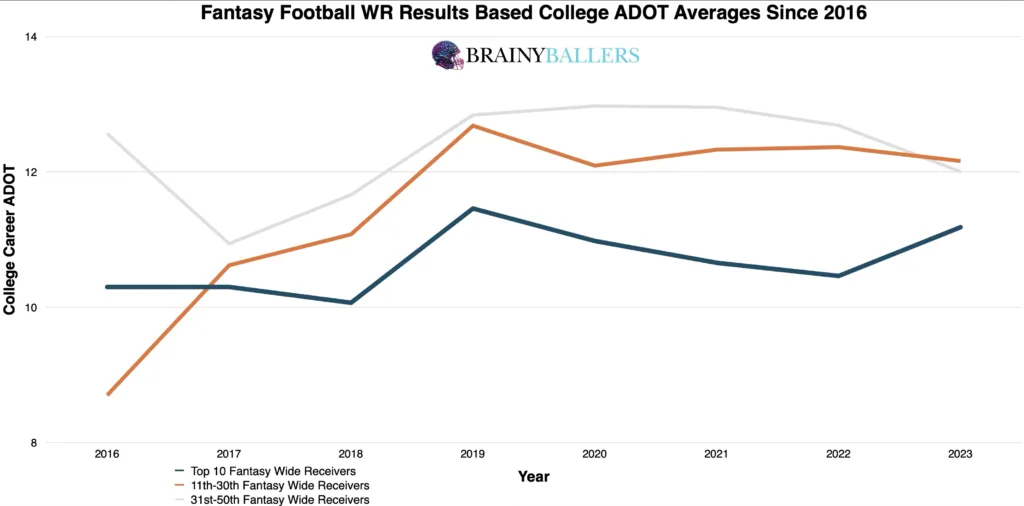
To look further into this, we charted the top and bottom 10 finishers’ career ADOTs by segmenting them out into 0.1 increments. This data reaffirmed our initial findings: lower ADOT’s correlated with higher NFL fantasy success more times than not. The weight and distribution of these charts showed this inverse relationship between target depth and NFL Fantasy scores.
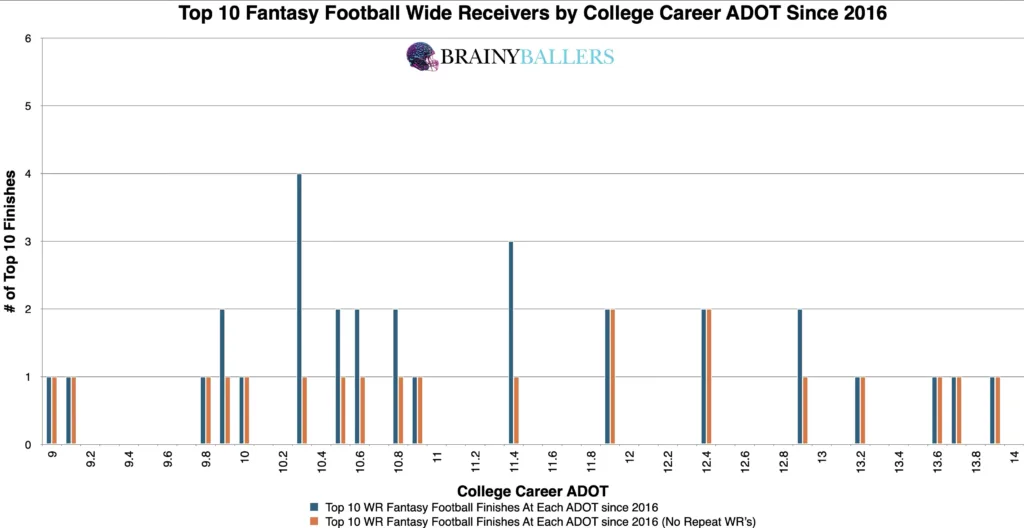
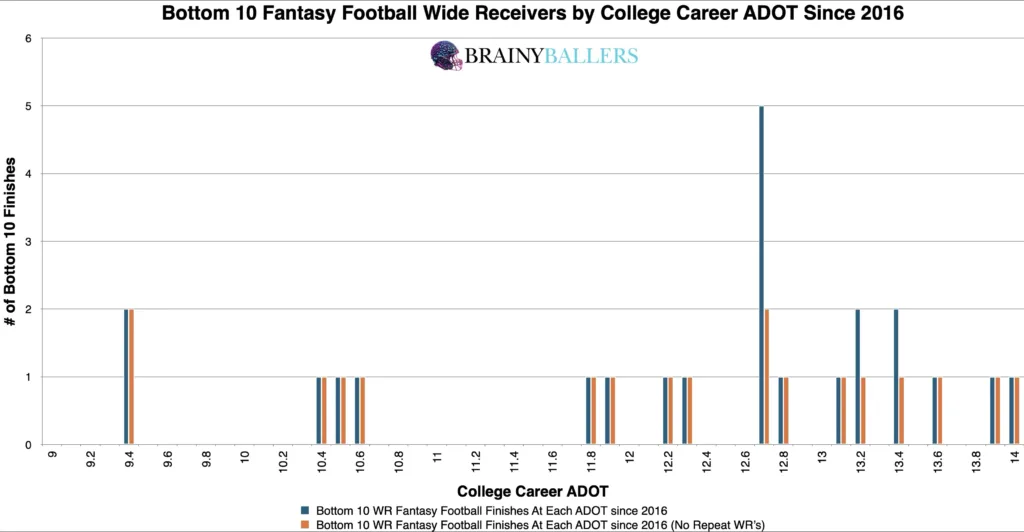
Our main goal was pinning down an ADOT optimal range that helps predict wide receiver success in the NFL. This threshold would ideally pinpoint the range where NFL performance balloons and where consistency remains high as well. To do this, we constructed a differences chart. This chart shows each WR’s college ADOT alongside the subsequent 0.5 increment while subtracting the bottom 10 finishers from the top 10 throughout that 0.5 increment. The chart’s desired outcome is a negative number for unique differences (Orange) and a positive number for non-unique differences (Blue). This would indicate the top level consistency we are hoping for. This analysis revealed the following insights: an 11.9 ADOT and below often coincided with improved performance, bringing us closer towards identifying an optimal college ADOT range, which we will attempt to verify as the optimal range next.

By making use of our spreadsheet, we were able to adjust the range in our spreadsheet to pinpoint the highest producing ADOT range. This led us to the following insight: Adjusting the threshold to a range of 8.9 to 12.9 college career ADOT prevailed a 39.7% hike in top 10 appearance rate compared to bottom 10. Therefore, this range will be the subject of our research going forward and will be our optimal range for college career ADOT. You should look for Wide Receivers with a college career ADOT within this range.
Due to these findings, ADOT could play a factor in our Star-Predictor Score (SPS) model. Since 14.3 is the highest ADOT seen since 2003 in the top 10, that will be the critical value in the SPS. The Star-Predictor Score (SPS) is a scouting tool designed to maximize investment potential and reduce risks when drafting rookies in Fantasy Football. It is proven to have a higher accuracy than draft capital alone to predict fantasy success. The SPS includes 13 to 17 metrics, with the exact number varying by the player’s position. All these metrics are pre-NFL, and some are invented by us, providing a complete analysis of a player’s analytical profiles. The SPS gained widespread notoriety for its high accuracy, having made it on Barstool and The Pat McAfee Show. The SPS can be found here.

We next used standard statistical methods to further validate our findings. We found a Pearson correlation value of -0.155 between college career ADOT and NFL Fantasy points. This indicates an inverse relationship between college career ADOT and future fantasy production, meaning lower college career ADOT’s have higher NFL fantasy scores typically. We are hoping for a minimum of 0.1, or an inverse correlation maximum of -0.1 when we study world-class athletes as we are. For reference to something that everyone acknowledges matters in prospect scouting, and to show the accompanying Pearson value, QB draft capital prevailed a -0.219 Pearson value.
*GET YOUR ORDER 100% REFUNDED WITH A CORRECT 2026 SUPERBOWL WINNER PREDICTION DURING CHECKOUT! NO EXTRA CHARGES TO PARTICIPATE!* What metric matters the most when scouting a rookie Running Back? What threshold should Running Backs achieve within that metric to be considered an elite prospect? How much should you value that stat above all other stats? Couldn't answer those questions? Rest easy, we have it handled for you. That's what this chart answers. Sort by importance and/or filter by position. Unlock by signing up with the links provided. $9.99/Year or $24.99 Lifetime access. Cancel anytime.
Our analysis culminated with a set optimal range of 8.9 to 12.9 ADOT. This range is what you should look for in Wide Receivers coming into the NFL. Our study prevailed a different narrative which is contrary to popular belief that Wide Receivers labeled as “screen pass reliant” or “dink-and-dunk” specialists don’t produce as much at the professional level. Here is the truth: lower ADOT players typically excel in NFL performance more than those with higher college career ADOT’s. This could be indicative of smaller receivers who need to rely on the screen passes excelling more than the larger bodied receivers who relied on the deep ball in college.
Our series has always sought to push the boundaries of sports analytics. This latest installment reaffirms our commitment to uncovering the hidden dynamics that define the game. Every Saturday, we’ll dive into intriguing questions, bust myths, and settle debates with thorough analysis. We welcome your input. Therefore, please leave comments or reach out with topics you’re eager to see dissected. All of our research can be found on our Analytics Page. Up next on our agenda for Part 61 of “Does It Matter?” is an examination of Wide Receiver College Career YAC/Reception: Does It Matter? If so, what’s the YAC/Reception threshold necessary for success? Mark your calendars; every Saturday we shed light on the topics that matter to you. All it takes is a quick question being asked and we will go to work for you!


BrainyBallers Buy-Hold-Sell Chart (All Players)
Get Your Products 100% Refunded By Predicting The Next SuperBowl Winner!

The “Does It Matter?” series, part 59 looked to uncover the role of a quarterback’s rookie touchdown per game (TD/G) in predicting
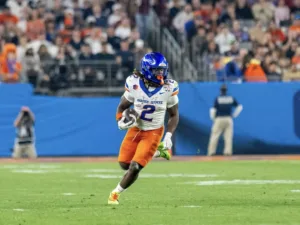
Having mapped out each position within our analytical model which predicts Fantasy Football points, we can now get a full picture of
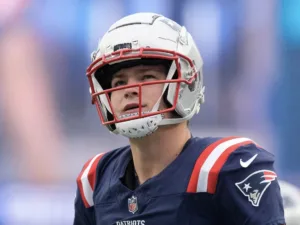
For our 58th installment of the “Does It Matter?” series, we looked into whether a quarterback’s rookie Yards Per Game (YPG) can